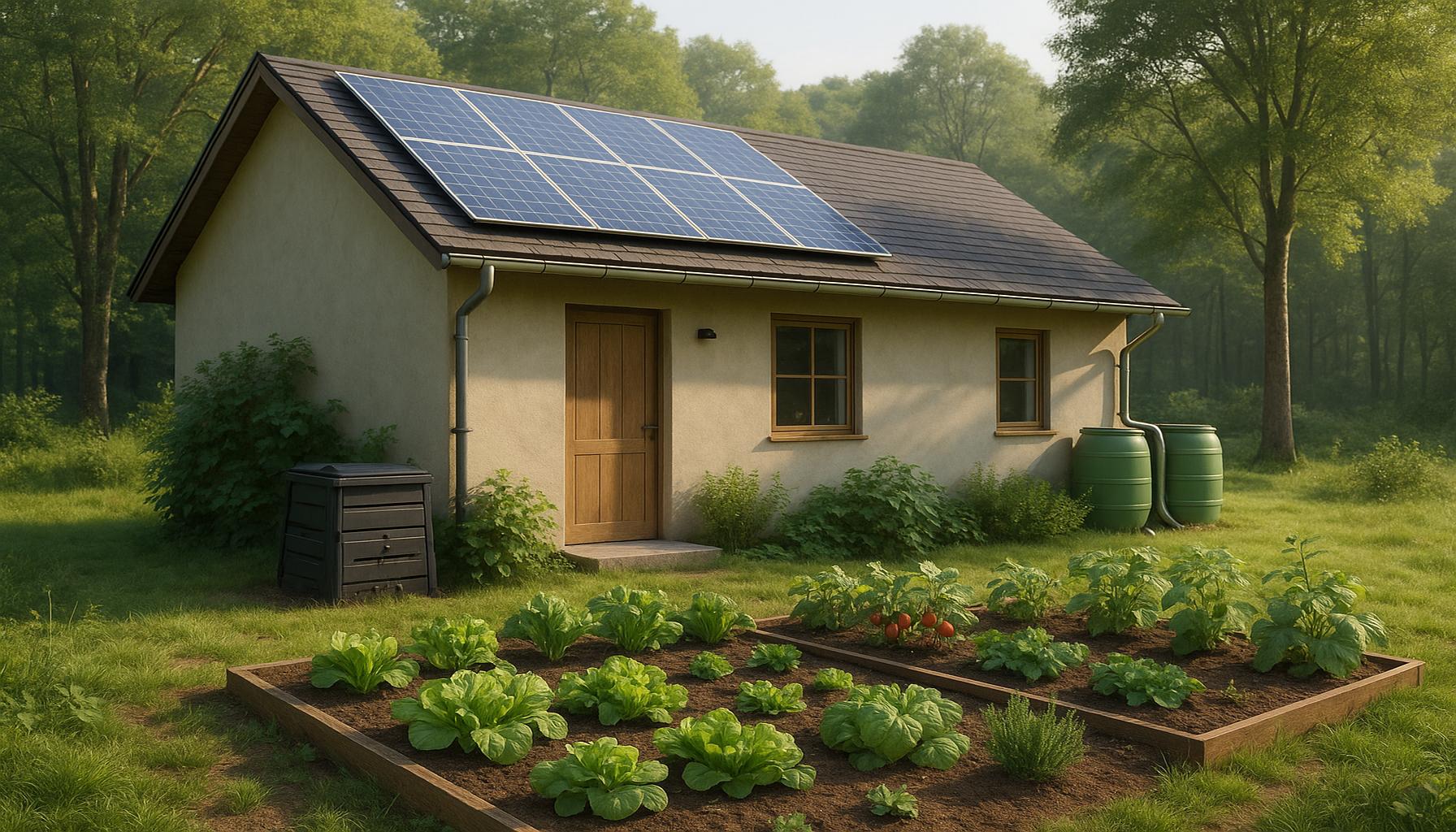Simplicity and Sustainability: How to Live Consciously and Ecologically

Discovering a Balanced Life
In a world increasingly characterized by consumerism and chaos, embracing simplicity and sustainability offers a refreshing alternative. This lifestyle fosters a deeper connection to ourselves, our communities, and the environment. By making conscious choices, we can live in a way that is both fulfilling and responsible. The allure of a fast-paced, materialistic society often leads individuals into a cycle of clutter and dissatisfaction. In contrast, living simply encourages us to prioritize what truly matters, thus enhancing our overall quality of life.
Key Concepts to Consider
- Minimalism: At its core, minimalism is about reducing physical and mental clutter. By embracing this concept, we can create spaces that promote mental clarity and focus. For example, adopting a minimalist wardrobe means selecting versatile pieces that can be mixed and matched rather than filling our closets with items we rarely wear. This not only simplifies decision-making but also fosters a greater appreciation for the items we do choose to keep.
- Eco-friendly practices: Incorporating eco-friendly practices into our daily routines can have a profound impact. This might mean choosing to use reusable bags instead of plastic ones, engaging in backyard composting, or even opting for green energy solutions, such as solar power. Small shifts can lead to significant changes over time, showcasing the importance of each individual’s effort in the larger fight against climate change.
- Mindful consumption: This idea emphasizes the importance of quality over quantity. Consumers are increasingly recognizing the value of brands that prioritize ethical production, fair labor practices, and sustainable materials. By supporting companies committed to these principles, we can drive a market shift toward more responsible production models. For instance, buying from local artisans or boutiques can bolster community economies while ensuring that the products we choose are crafted thoughtfully.
The journey toward a more sustainable future involves understanding the impact of our daily actions. For instance, consider the following:
- Reducing plastic use can significantly decrease ocean pollution, with an estimated 8 million tons of plastic entering the oceans each year. By choosing alternatives, such as glass or stainless steel containers, we contribute to protecting marine life.
- Opting for local food not only supports community farmers but also reduces carbon footprints associated with transportation. Farmers’ markets, which are abundant across the U.S., offer fresh produce while strengthening local economies and promoting seasonal eating.
- Emphasizing energy efficiency in homes, such as through the use of LED lighting or energy-efficient appliances, conserves resources and can save homeowners considerable amounts on utility bills over time. Additionally, weatherproofing homes can enhance energy efficiency and comfort.
As you explore pathways to live more consciously, remember that these proactive steps not only benefit the environment but also enhance personal well-being. Embracing simplicity and sustainability is not about sacrificing comfort; rather, it’s about making informed choices that lead to a more harmonious existence. This article will guide you through practical strategies to simplify your lifestyle while embracing sustainability, encouraging a more balanced life in a complex world.
DIVE DEEPER: Click here to enhance your understanding
Embracing Minimalism in Everyday Life
At the heart of the movement towards simplicity and sustainability lies the principle of minimalism. This philosophy encourages individuals to strip away the unnecessary in favor of what is truly essential and valuable. From decluttering your living space to reassessing personal values, minimalism can lead to a profound transformation that impacts both mental well-being and environmental sustainability. Less clutter often translates into less stress, allowing for clarity in thoughts and priorities. Notably, research indicates that a cluttered environment can affect cognitive functioning and lead to increased anxiety levels. Prioritizing simplicity can create a nurturing atmosphere conducive to peace and creativity.
Practical Minimalist Strategies
Incorporating minimalism into daily life can be both fulfilling and straightforward. Here are some practical strategies to consider:
- Start Small: Begin by tackling small areas of your home, such as a drawer or a closet. The act of decluttering a single space can provide a sense of accomplishment, motivating you to continue the journey.
- The One-Year Rule: If an item has not been used or worn in the last year, consider donating or discarding it. This helps in distinguishing between necessities and mere possessions while promoting a more sustainable wardrobe.
- Embrace Quality Over Quantity: Invest in high-quality products that are durable and multifunctional. This approach can reduce waste over time and may lead to significant savings in your budget.
Living sustainably extends beyond merely reducing the number of items we own. It also requires a shift in our mindset about consumption. In the United States, the average consumer discards about 4.9 pounds of trash daily, contributing to the overwhelming waste problem. Each decision we make, from the products we buy to the food we consume, carries implications for the environment. Shifting towards a more mindful approach can encourage habits that promote longevity and reduce waste.
The Role of Eco-Friendly Practices
Integrating eco-friendly practices into everyday routines is essential for anyone looking to reduce their environmental footprint. Simple changes can make substantial impacts. For example, the adoption of a plant-based diet not only benefits personal health but also has a lighter ecological footprint compared to meat-heavy diets. The production of plant-based foods typically requires significantly fewer natural resources.
Here are a few eco-friendly practices to incorporate into your daily life:
- Reduce Water Usage: Simple habits like taking shorter showers or fixing leaks can conserve precious water resources and lower utility bills.
- Choose Sustainable Transportation: Whenever possible, opt for walking, biking, or public transit instead of driving. Each mile not traveled in a personal vehicle reduces carbon emissions significantly.
- Support Local and Sustainable Businesses: Purchasing from businesses that prioritize sustainability helps promote responsible consumerism and strengthens local economies.
By embracing simplicity and sustainability, individuals can embark on a journey toward a conscious lifestyle. Such choices not only contribute to personal happiness but also foster a sense of responsibility towards the planet. The pursuit of a balanced life enriched by minimalism and eco-friendly practices paves the way for a healthier world for future generations.
| Advantage | Description |
|---|---|
| Minimalism | Embracing fewer possessions reduces clutter and stress, allowing for a more intentional lifestyle. |
| Ecological Footprint | Opting for sustainable products decreases environmental impact and supports ethical brands. |
| Mindful Consumption | Engaging in thoughtful purchasing habits fosters responsible resource use and enhances community businesses. |
| Health Benefits | A sustainable lifestyle often incorporates healthier foods, boosting physical well-being. |
Adopting the principles of simplicity and sustainability can significantly transform our day-to-day living. By highlighting key advantages such as minimalism, individuals can experience reduced clutter, enhanced focus, and a clearer mind. Moreover, curtailing one’s ecological footprint can bring about not only personal change but a ripple effect in larger communities as ethical brands and sustainable products gain traction. When individuals practice mindful consumption, they not only support local economies but also foster a sense of responsibility for the environment. Switching to organic or locally sourced products not only stimulates healthier eating habits but can also lead to improved overall health, further promoting a balanced lifestyle.Imagine the potential of collectively moving towards these practices: living more consciously, fostering ecological awareness, and embracing a lifestyle that significantly minimizes the detrimental effects on our planet. The concepts of simplicity and sustainability are not just trends; they are pivotal for a more balanced and conscientious way of living that benefits everyone.
DIVE DEEPER: Click here to enhance your productivity
Building Community Connections for Sustainable Living
The quest for simplicity and sustainability is often not a solitary endeavor; rather, it’s a communal effort that flourishes when individuals support each other. Community connections play a vital role in fostering a culture of sustainability, where collective practices can lead to broader environmental impacts. By engaging with local groups and initiatives, individuals can share resources, knowledge, and inspiration, thereby amplifying their commitment to living more consciously.
The Importance of Local Collaborations
Local collaborations can take various forms, from community gardens to neighborhood clean-ups. These initiatives not only beautify the environment but also create a sense of belonging among participants. A study from the Kauffman Foundation revealed that social connections can enhance individual motivation to adopt sustainable behaviors. When people see their neighbors actively engaged in eco-friendly practices, they are more likely to join in and contribute to a collective sustainability mission.
Consider these ways to connect with your community for sustainable living:
- Join a Local Sustainability Group: Many cities have organizations dedicated to promoting ecological practices. These groups often organize events and provide resources that reinforce sustainable habits.
- Participate in Community Supported Agriculture (CSA): By subscribing to a CSA, you directly support local farmers and receive fresh, seasonal produce. This not only bolsters local economies but also reduces the carbon footprint associated with transporting food.
- Share Resources: Tools or skills-sharing groups enable individuals to borrow items instead of purchasing new ones, thus minimizing waste. By circulating equipment like gardening tools or camping gear, the community can save money and the environment simultaneously.
Repurposing and Upcycling for a Sustainable Home
Another essential aspect of living sustainably is the creative act of repurposing and upcycling. This process allows one to view everyday items in new ways, transforming what could be discarded into valuable resources. According to a study conducted by the Ellen MacArthur Foundation, repurposing materials can significantly reduce the need for new resources, thereby lessening one’s overall environmental impact.
Implementing repurposing and upcycling in your life can start with simple projects:
- Furniture Makeovers: Instead of buying new furniture, consider refurbishing old pieces with paint or new upholstery. Not only does this save money, but it also breathes new life into cherished items.
- DIY Projects: Transform glass jars into storage solutions or planters, giving new purpose to what would otherwise end up in the recycling bin.
- Clothing Swaps: Exchange clothes with friends to refresh your wardrobe without spending money or contributing to fast fashion waste.
Incorporating these tactics into your life invites creativity and resourcefulness, inherently decreasing your reliance on new products. With an increasing number of resources available online, especially in a digital age, anyone can find tutorials or inspiration to start their own upcycling projects.
Mindful Consumerism: The Art of Conscious Choices
Finally, yet importantly, the concept of mindful consumerism emphasizes the significance of making informed purchasing choices that align with your values. In a market dominated by fast fashion and disposable goods, intentional buying can drastically shift local and global economies. In 2021, it was estimated by the Consumer Federation of America that 92% of Americans considered sustainability when shopping, highlighting that mindful consumerism is resonating with the public.
To enhance your practice of mindful consumerism, consider the following:
- Research Brands: Before making a purchase, investigate the practices of the companies you support. Look for certifications such as Fair Trade or B Corp, which indicate a commitment to sustainable and ethical practices.
- Prioritize Second-Hand Purchases: Thrift stores and online marketplaces like Poshmark or eBay not only offer unique items but also promote recycling and reuse in retail.
- Make a Shopping List: Creating a list and sticking to it can help avoid impulse purchases, steering you towards intentional choices rather than unnecessary purchases.
By embedding these strategies into daily life, individuals can cultivate a lifestyle that champions simplicity and sustainability while fostering community bonds and creating a brighter, more environmentally friendly future.
DISCOVER MORE: Click here to deepen your understanding
Conclusion: Embracing a Sustainable Future Through Simplicity
In an era where environmental concerns are more pressing than ever, adopting a lifestyle rooted in simplicity and sustainability is not just a trend, but a crucial necessity. As we have explored, creating community connections, engaging in local collaborations, and embracing the art of repurposing and upcycling are powerful avenues to not only preserve our environment but also enrich our lives. By consciously evaluating our consumer habits, we can steer ourselves towards a future where every choice reflects our values, contributing to a healthier planet.
Remember, sustainability is a multifaceted journey, and implementing even the smallest changes can have significant impacts. Participating in community-supported agriculture or thrift shopping not only nurtures local economies but also cultivates a mindset focused on resourcefulness and care for the earth. Engaging with friends and neighbors fosters a sense of belonging and collective commitment to a brighter future.
As we make informed decisions and prioritize intentional living, we challenge the status quo of wasteful consumption, shaping a more sustainable environment for generations to come. Ultimately, the principles of simplicity and sustainability empower us to live not just for ourselves, but for the planet, reinforcing our connection to each other and the world we inhabit.
The choice is ours — to live consciously, embracing a lifestyle that honors both our needs and the intricate web of life that sustains us. Together, let us stride confidently down the path of sustainability, making our world not just simpler, but profoundly richer and more resilient.


